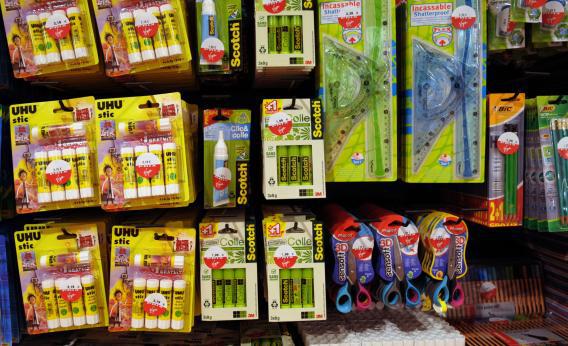Remember the days when back-to-school shopping meant schlepping your cranky kids to Staples or Office Depot, only to find that they’re out of half the things you need and the other half is grievously overpriced? Thank goodness for the Internet, right?
Not so fast. StellaService, an online customer service ratings startup, decided this year to study just how much money shoppers save by purchasing school supplies on sites such as Walmart.com and Staples.com instead of going to the stores themselves. Their counterintuitive finding: none.
In fact, the firm’s mystery shoppers spent significantly more to buy the same or comparable items online as they did offline. The average in-store bill for 13 items, including No. 2 pencils, a three-ring binder, a calculator, and a glue stick came to $31. Online, it was $53, including an average of $10 for shipping. That means the items would have been pricier on the Web even if shipping were free.
Not only that, but some of the physical stores had a better selection than their digital counterparts. Target.com, for instance, didn’t offer many of the items on the list at all. Costco.com had items in stock, but with minimum order requirements—such as three boxes of ballpoint pens—that drove up prices.
Finally, clunky and confusing online checkout processes meant that customers spent almost as much time completing their purchases online as they did in store checkout lines. (And, of course, those online orders generally take several days to arrive.)
What’s going on here? To find out, I talked with StellaService’s CEO, Jordy Leiser. Two things became clear.
First, the study’s findings are genuine, as far as they go. Many office-supply stores really do seem to offer better back-to-school deals offline than they do on their websites. The reasons aren’t entirely clear. Maybe they see in-store discounts as loss leaders, or perhaps they just haven’t mastered the online retail business model yet. Either way, it seems that in at least some cases, shoppers may be better off ducking into their local OfficeMax than going to OfficeMax.com.
Second, though, it would be a mistake to generalize from this study to conclude that offline shopping is superior to online shopping overall. Just because brick-and-mortar stores offer great back-to-school sales doesn’t mean they’re cheaper than their online counterparts for other items, or at other times of the year.
And, importantly, Leiser noted that the study only compared the online and offline experiences of specific stores that offered both. That means that it did not include online retail giant Amazon.com. It also means that it did not take into account the relative ease of comparison-shopping online. If you drive to Target, it’s a big hassle to then drive to Office Depot to see if their prices are better. But in your Web browser, you can toggle between numerous sites with the click of a button.
Leiser said the proper takeaway from the study for consumers is simply that you can’t assume that things will be cheaper just because you’re buying them online—you have to be smart about it. And from a business perspective, the study may help explain why traditional retailers’ websites have had a hard time making inroads against online-only competitors like Amazon.
“We thought online would be hands-down, no-brainer, the number-one experience,” Leiser said. “Overall it was less convenient than we thought.”

Screenshot.
